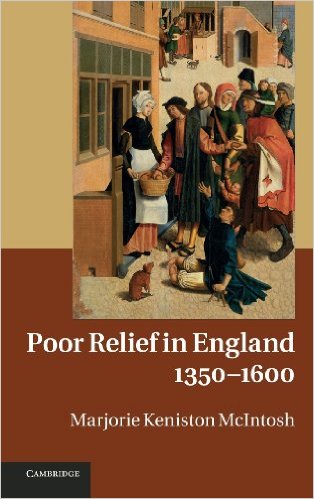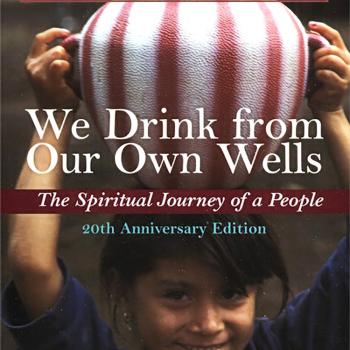 Consider this more of a friendly “book recommendation” than a “review.” I don’t wish to outline the book’s general shape, nor will I analyse its arguments in much detail. I only want to point it out as an up-to-date and valuable piece of research that sheds important light on the subject of poor relief.
Consider this more of a friendly “book recommendation” than a “review.” I don’t wish to outline the book’s general shape, nor will I analyse its arguments in much detail. I only want to point it out as an up-to-date and valuable piece of research that sheds important light on the subject of poor relief.
I should emphasize that I am not pointing this book out primarily as fodder for the “Protestant vs. Catholic” debate. It may be useful in that area, but it is more interesting for what it can teach us about our assumptions regarding charity, welfare, and social attitudes toward the poor in history.
Published in 2012 (paperback in 2013), Marjorie Keniston McIntosh’s Poor Relief in England, 1350 – 1600 provides an extremely well-researched study of the transformation that took place in social attitudes as well as in social institutions through the Reformation in England, particularly as they pertain to poverty.
Essentially she describes the state of licensed begging, almshouses, laws, hospitals, and parish relief systems as they existed immediately prior to the Reformation, and then seeks to understand what happened during and after.
The operation of almshouses in England peaked in 1520 at 617.
“Across the next three decades, nearly half of those institutions were closed due to royal and Parliamentary policies that dissolved or appropriated resources from the religious bodies that had previously operated them. Although new foundations attempted to fill the gap, only two-thirds as many residential institutions were functioning in the 1560s as in the 1520s.” (p. 7)
She is essentially described a concentration of power into the hands of the State, which represents a “secularization” of poor relief which began predominately by obliterating the structures of relief that had previously existed. Where it did not obliterate them, it took ownership and control parish activities as they related to the poor.
Speaking of partish-based aid, McIntosh reports that, “from the mid sixteenth century onwards they were assigned additional, secular duties by Parliamentary legislation. In those respects they served in effect as arms of the state.” (p. 8)
This did not just mean a consolidation of ownership and a reduction in quantity of existing forms of aid–it also meant a reduction in diversity of forms that aid might take:
“Many forms of assistance to the poor were lost between 1536 and 1553 as secondary consequences of the closure of the monasteries and convents, the lay religious fraternities, and the chantries that provided masses for the dead. The crown confiscated the property of those institutions as well as much of the land and goods owned by the parishes, leaving only enough to support a simple Protestant service.” (pps. 19-20)
“The multiple arms of the pre-Reformation Catholic Church were heavily involved in helping the poor. When those forms of assistance were terminated in the mid sixteenth century, the total array of relief became less varied, offering fewer types of aid to people in need.” (p. 27)
One of the more interesting subjects covered in the study is transfer of supervision of poor houses and aid distribution from churchmen to “Justices of the Peace.” Although the responsibility to administer aid was still in the hands of the parishes, the oversight became the role of the JPs, which meant that decisions would hitherto be guided not by a theologically under-pinned morality of giving, but by the letter of the law, which meant that mercy was less of a virtue and more of an afterthought, if it factored in at all.
McIntosh also takes care to outline the change in attitude toward the poor as she finds it in legal verbiage. Rather than charity as a meritorious act, the new laws concerning the poor become much more concerned with control of aid recipients, placing much more emphasis on behavioral conditions the poor must meet, and implying that poverty was less a result of misfortune and more a moral short-coming on the part of the needy, an attitude McIntosh connects with the Puritan mentality.
Another valuable insight is McIntosh’s insistence that we not view “private charity” as something separate from public efforts to aid the poor when we are considering pre-Reformation poor relief. She rightly explains that the Catholic Church applied considerable pressure on its members and that the funds it distributed through its massive web of charitable organizations could not rightly be considered “voluntary charity” as we imagine today when we think of money freely given to American churches and then distributed from there to the poor.
The obvious inference is that the idea that religious charity was once a voluntary thing depending on the good-will of believers is a myth that survives only by the fact that our churches today are utterly powerless to assert comparable pressure on their members. We assume that the 14th century Church, which collected and distributed such massive incomes, must have done so based on generosity plain and simple, because we cannot imagine them wielding such a commanding presence in the economic lives the the population.
McIntosh is no writing a criticism of the Reformation, and she is not taking the Catholic side in any debate. In fact she seems to take the view that the post-Reformation consolidation of poor relief resulted in greater “efficiency” in the distribution of aid in the long run, and eventually led to the welfare state of today. As a distributist, that is not my view, but I don’t have to agree with her conclusions to value her research, which is quite good.












